
The Ultimate Guide to Preparing Iguana Meat for First-Timers
Why This Guide Matters
So you've decided to take the leap into cooking iguana meat—often called "chicken of the trees" by enthusiasts. Maybe you're curious about this sustainable protein source, or perhaps you're looking to explore traditional Caribbean and Latin American cuisine. Whatever brought you here, you're in the right place.
Preparing iguana meat for the first time can feel intimidating, but with the right guidance, it's actually quite straightforward. This comprehensive guide will walk you through everything from sourcing to storage, ensuring you handle this unique protein safely and confidently. Once you've mastered preparation, you'll be ready to explore various cooking techniques and flavor pairings to create delicious dishes.
Sourcing Your Iguana Meat
Before we dive into preparation, let's talk about where to get iguana meat. Always source from legal and reputable suppliers. In some regions like Florida, iguanas are an invasive species, and there are programs that encourage their harvesting. In parts of Central America and the Caribbean, iguana meat is sold in local markets.
Key considerations when sourcing:
- Check local regulations regarding iguana harvesting and consumption
- Purchase from licensed suppliers when available
- Ensure the meat has been properly handled and stored
- Fresh iguana meat should have a mild scent, similar to chicken
Understanding the Anatomy: Where's the Good Meat?
Not all parts of an iguana provide equal amounts of usable meat. Here's what you need to know:
Prime cuts are found in:
- The legs - Four meaty limbs with tender, flavorful meat
- Along the spine - Long strips of meat running the length of the back
- The tail - Surprisingly meaty and often considered a delicacy
Pro tip: Don't bother with the rib meat—it's minimal and not worth the effort to extract.
Initial Cleaning and Butchering
If you're working with a whole iguana, here's your step-by-step process:
The Traditional Piecemeal Method (Recommended for Beginners)
- Remove the four legs - Cut at the joint where they meet the body
- Cut off the feet - These have no usable meat
- Divide each limb - Cut in half at the central joint (you'll have 8 pieces)
- Remove the tail - One clean cut at the base
- Cut off the spines - Carefully trim away the dorsal spines
- Remove the head and entrails - Standard butchering practice
You should end up with approximately 9 usable pieces.
The Whole Method (For Experienced Cooks)
Alternatively, you can keep the iguana whole by opening the belly lengthwise and removing all the organs and entrails. This method works well if you plan to roast or stew the entire animal.
The Critical Skinning Process
Iguana skin is tough—really tough. Here's a technique that makes the job much easier:
The Boiling Method:
- Bring a large pot of salted water to a rolling boil
- Submerge the iguana pieces for 10-15 minutes
- Remove and let cool slightly (until you can handle them safely)
- Using a sharp knife, gently peel away the skin—it should come off much easier now
- Discard all skin
Note: If you prefer not to skin the iguana before cooking, you can parboil it in salted water for 20-30 minutes before roasting or stewing. The skin can be removed after cooking.
Food Safety: The Non-Negotiables
Let's talk about the elephant in the room—or rather, the reptile on the cutting board. Iguanas can carry salmonella bacteria, just like chickens and other poultry. This means proper handling is absolutely crucial.
Essential Safety Practices:
- Prevent cross-contamination - Use dedicated cutting boards and utensils for raw iguana meat
- Wash thoroughly - Clean all surfaces, tools, and your hands with hot, soapy water after handling raw meat
- Cook to proper temperature - The USDA recommends 165°F (74°C) internal temperature to kill salmonella (learn more in our guide on determining perfect doneness)
- Never use a microwave - Microwaving is not reliable for killing salmonella in iguana meat
- Use a meat thermometer - This is your best friend for ensuring safety
Tenderizing and Pre-Treatment
While iguana meat is generally tender (despite what you might expect), pre-treatment can enhance both texture and flavor:
The Vinegar or Lime Soak
Many traditional recipes call for soaking the meat in an acidic solution:
- Combine equal parts water and white vinegar (or use fresh lime juice)
- Submerge the cleaned meat pieces
- Refrigerate for 1-2 hours
- This removes any gamey flavor and helps tenderize
Salted Water Parboil
Another effective technique:
- Bring salted water to a boil (about 1 tablespoon salt per quart of water)
- Add iguana pieces and cook for 20-30 minutes
- This pre-cooking makes the meat incredibly tender
- Perfect preparation before roasting, grilling, or frying
Storage Guidelines
Refrigeration: Fresh, cleaned iguana meat will keep for 1-2 days in the refrigerator when properly wrapped.
Freezing: For longer storage, iguana meat freezes well:
- Wrap tightly in plastic wrap, then aluminum foil
- Store in freezer-safe bags, removing as much air as possible
- Label with the date
- Use within 3-4 months for best quality
- Thaw in the refrigerator, never at room temperature
Common Mistakes to Avoid
1. Skipping the thermometer - Visual cues alone aren't enough to ensure safe cooking temperatures.
2. Over-cooking - While you need to reach 165°F, going far beyond that can make the meat dry and tough.
3. Rushing the skinning - Take your time or use the boiling method—rushing leads to wasted meat.
4. Neglecting the acid soak - Even mild iguana meat benefits from this traditional treatment.
5. Using dull knives - Sharp knives are safer and make the butchering process much easier.
What to Expect: Texture and Flavor
If you've never tasted iguana meat, you're in for a pleasant surprise. The flavor is mild—think of a cross between chicken and white fish, with a slightly sweet undertone. The texture is tender when properly prepared, similar to chicken thigh meat.
Iguana meat readily absorbs the flavors of whatever seasonings and marinades you use, making it incredibly versatile in the kitchen.
You're Ready to Cook!
With your iguana meat properly cleaned, butchered, and prepared, you're ready to explore the world of iguana cuisine. Whether you're planning to braise, grill, fry, or stew your iguana, you now have the foundational knowledge to do it safely and successfully.
The most important takeaways? Source responsibly, handle safely, cook to 165°F, and don't be intimidated. Thousands of cooks across the Caribbean and Latin America prepare iguana meat every day—and now you can too.
Ready for your first iguana recipe? Start with a simple stew or curry where the long, slow cooking will guarantee tender, flavorful results. Check out our guide to 5 essential cooking techniques to master different preparation methods, and explore our herbs and spices guide to discover perfect flavor combinations. Trust the process, follow food safety guidelines, and enjoy exploring this sustainable, traditional protein source.
Happy cooking, and welcome to the world of "chicken of the trees"!
Enjoyed this article? Share it!
Comments
Please log in to leave a comment
No comments yet. Be the first to comment!
